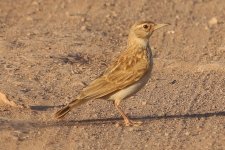Arbu
Well-known member
People are very dismissive of Ryanair, but I kind of like their minimalism, and I was intrigued to see that they had started flying to Ouarzazate, so off I went. I loved the way the pilot announced "Welcome to your Ryanair flight to ... er ... I'm not even going to try to pronounce that." They must have a great passion for the destinations they fly to.
Anyway, I didn't have many lifers to try for, so booked myself four nights at Ait Bennhadou, with a plan to take some day trips. Walking around the area I saw lots of Rufous Bushchats, Black-eared, Black and White-crowned Wheatear, some Corn Buntings and Trumpeter Finches.
On 24th I drove up to the Tizi n'Tichka pass and took a dirt road higher, then walked on to the summit of a mountain at about 3600m. Atlas Wheatears and Horned Larks were everywhere, but I could find no sign of Crimson-winged Finches at all. Perhaps I wasn't high enough, and they are all in fact crowded on the summit of Mt. Toubkal.
On 25th I drove out to the Ecolodge Ile d'Ouarzazate and paid to sit by their pool for a bit while looking out across the steppe for birds. There actually wasn't much to see apart from lots of Crested Larks, but I did see one lark briefly which walked out from some shrubs and then promptly disappeared. It looked very good for Dupont's Lark (ssp. duponti). Using the Collins Bird Guide I can't tell whether this would be the subspecies at Ourzazate or whether it would be margaritae. The former is listed for north of the Atlas and the latter for Algeria, but Ourzazate is neither. Certainly it seemed the right sort of habitat for Dupont's.
Before dusk I walked out onto the steppe and tried to identify some of the numerous larks there. Most seemed to be Crested, and some Thekla, and there was one party of larks with quite brown caps, which I suppose must have been Greater Short-toed. Also one lark walked on the road in front of me (photo). It showed a couple of feathers of crest, and looked a lot like the head of the Crested shown with the Dupont's Larks in Collins (page 257) but nothing like the main pictures of Crested Larks in that guide (page 249). I think it must have been a Crested Lark because it was too confiding to be a Dupont's Lark. A couple of Barbary Partridges flew out at sunset, and then I started walking back, playing the call of the Egyptian Nightjar, which had been reported a couple of months earlier on ebird. And lo! They responded. I saw two at one time and there was another one calling in the distance, so it would seem that they must have now bred. They were rather flighty, so no photos.
I had a puncture driving back, so abandoned plans to go out east to the Tagadilt track the next day, as it didn't seem a good idea to drive that far on the spare tyre, and there were no lifers for me out there.
Anyway, I didn't have many lifers to try for, so booked myself four nights at Ait Bennhadou, with a plan to take some day trips. Walking around the area I saw lots of Rufous Bushchats, Black-eared, Black and White-crowned Wheatear, some Corn Buntings and Trumpeter Finches.
On 24th I drove up to the Tizi n'Tichka pass and took a dirt road higher, then walked on to the summit of a mountain at about 3600m. Atlas Wheatears and Horned Larks were everywhere, but I could find no sign of Crimson-winged Finches at all. Perhaps I wasn't high enough, and they are all in fact crowded on the summit of Mt. Toubkal.
On 25th I drove out to the Ecolodge Ile d'Ouarzazate and paid to sit by their pool for a bit while looking out across the steppe for birds. There actually wasn't much to see apart from lots of Crested Larks, but I did see one lark briefly which walked out from some shrubs and then promptly disappeared. It looked very good for Dupont's Lark (ssp. duponti). Using the Collins Bird Guide I can't tell whether this would be the subspecies at Ourzazate or whether it would be margaritae. The former is listed for north of the Atlas and the latter for Algeria, but Ourzazate is neither. Certainly it seemed the right sort of habitat for Dupont's.
Before dusk I walked out onto the steppe and tried to identify some of the numerous larks there. Most seemed to be Crested, and some Thekla, and there was one party of larks with quite brown caps, which I suppose must have been Greater Short-toed. Also one lark walked on the road in front of me (photo). It showed a couple of feathers of crest, and looked a lot like the head of the Crested shown with the Dupont's Larks in Collins (page 257) but nothing like the main pictures of Crested Larks in that guide (page 249). I think it must have been a Crested Lark because it was too confiding to be a Dupont's Lark. A couple of Barbary Partridges flew out at sunset, and then I started walking back, playing the call of the Egyptian Nightjar, which had been reported a couple of months earlier on ebird. And lo! They responded. I saw two at one time and there was another one calling in the distance, so it would seem that they must have now bred. They were rather flighty, so no photos.
I had a puncture driving back, so abandoned plans to go out east to the Tagadilt track the next day, as it didn't seem a good idea to drive that far on the spare tyre, and there were no lifers for me out there.




